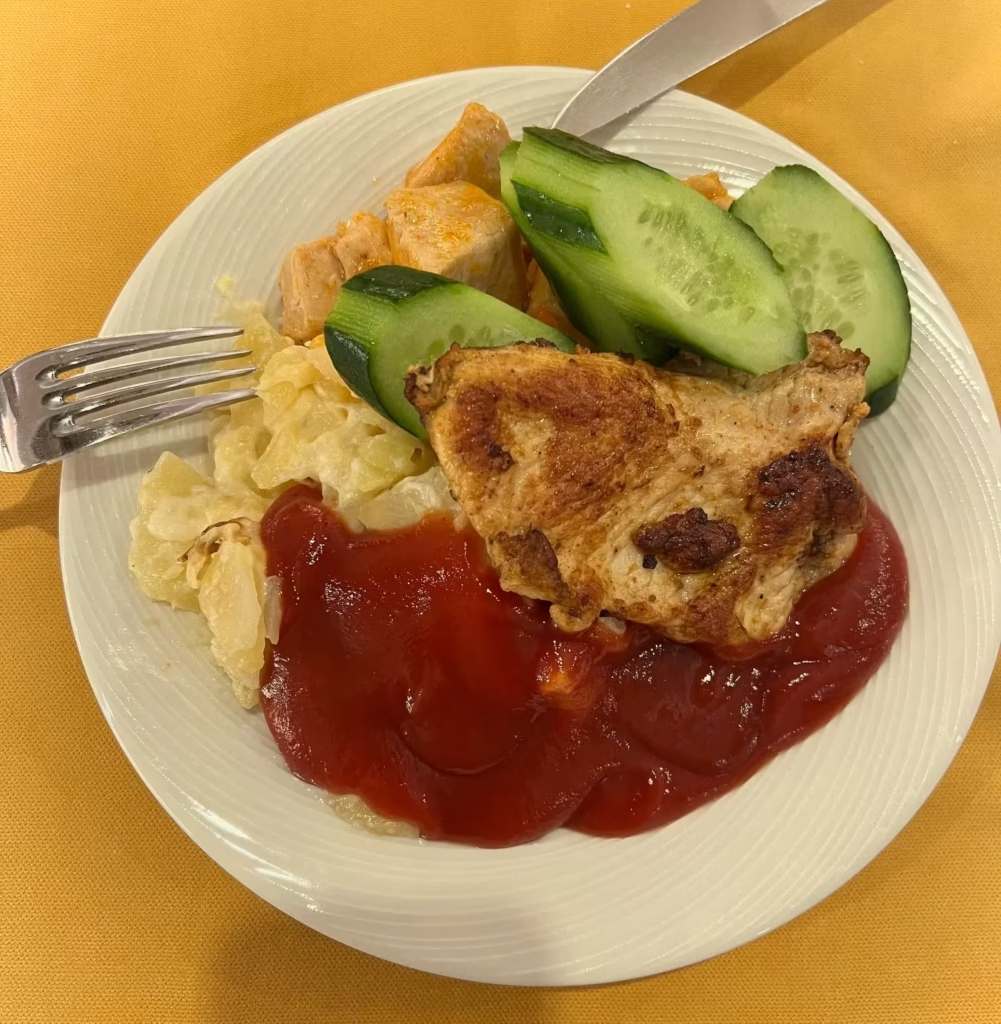Published on July 26, 2025 by Filip
Last updated on July 29, 2025

Cooking for yourself should feel liberating and a continuous exercise in soggy leftovers and spoiled produce. For many people that live alone, it’s hard to avoid wasting food. We buy a pack of chicken thighs, use two, and forget about the rest.
Our vegetables wilt in the drawer before we’ve figured out what to do with them, and let’s not even talk about the half-used cans of beans you promised yourself would finish.
The good news is that with the right strategies, tools, and mindset, you can learn how to cook for one person without wasting food and remain satisfied in the process.
This guide breaks down what actually works, without any gimmicks and meal kits, but providing smart and realistic solutions for one-person households.
Key Takeaways: Cooking for One Without Wasting Food
- Plan in meals, not ingredients – Buy what you’ll actually cook this week.
- Freeze smarter – Pre-portion sauces, proteins, and cooked meals.
- Cook “1.5 servings,” not 4 – Enough for now, maybe leftovers for tomorrow.
- Repurpose base ingredients – One batch, multiple meals, added variety.
- Use compact tools – Like air fryers, rice cookers, and foldable boards.
- Keep go-to meals in rotation – 3-5 favorites + 1 “lazy” backup = no waste.
Why Cooking for One Feels So Wasteful
Cooking for one isn’t hard because you don’t know how to cook, but because most of the food system is not designed for solo living.
- You’re forced to buy more than you need – Grocery stores are built around family-sized packs and “value” deals.
- Most recipes assume you’re feeding a group – The internet is flooded with 4-6 serving recipes, and trying to halve them doesn’t work as well in practice.
- Small fridges = limited storage – Compact living typically means limited freezer space and shallow shelves, which makes batch cooking and food storage tricky.
- Mental friction – When you are tired, busy, or unmotivated, it’s easier to skip the leftovers and order in. Over time, this leads to wasted food.
Quick Stat: According to the EPA, nearly 40% of all food waste happens at the household level, and solo households are among the highest contributors per capita.
You won’t need to overhaul your way of life in order to waste less, because your solution is within simple tweaks of what you buy, how you store it, and how you think about cooking for yourself.
As you scroll down, I list the top 6 tips and methods to prevent food waste when cooking for one, sharing my best kitchen gear and cooking tips for efficient meals.
Top 6 Methods for Cooking for One Without Wasting Food
These are my best tips and tricks I have to share thanks to years of experience in cooking and living alone.
1. Shop Smarter – Grocery Hacks for Solo Living
Preventing food waste begins before the cooking process – at the store or supermarket. Most people will overbuy out of habit, rather than hunger. If you live alone, shopping like a family of four is the fastest way to end up with slimy spinach and mystery Tupperware contents.
Here is how to make smarter and smaller purchases that will fit your solo lifestyle:
Buy Loose, Not Packaged
Whenever possible, skip the pre-bagged produce and head for the bins. If you need just one onion, grab it and move on. Local markets, bulk bins, and stores with “by weight” pricing are the solo cook’s best friend.
Think in “Meal Units”, Not Ingredients
Don’t just buy “chicken”, but think “2 chicken meals”. Don’t just grab “broccoli”, but rather ask “What will I use this for this week?”
This mindset will help you avoid any “aspiration buys”, and keeps your fridge relevant and on point to your real cooking patterns.
Embrace the Freezer Section
Frozen fruits, vegetables, and proteins should be your low-waste backup plan. You can scoop out a handful of peaks or defrost just two filets of fish, with no spoilage pressure and waste.
If you eat bread, freeze half of your loaf immediately after purchase, even if it’s fresh. You will thank yourself later.
Avoid Items with Short Shelf Lives (Unless Planned)
Things like soft berries, bagged salad, or open deli meats can go bad in days, so only buy them if you already know you will use them. For everything else, go with self-stable and long-lasting, such as cabbage, carrots, eggs, canned tuna, rice, and oats.
Make a Mini-Meal Plan (Even Just for 3 Days)
You don’t need a full Pinterest meal plan, but write down 3-5 meals you are likely to make and shop with those in mind. You will avoid buying random stuff and reduce your decision fatigue.
Bonus Tip: Micro-prep as Soon as You Get Home
What this means: wash the greens, dice your onions, chop your half bells of peper, because just doing this makes you a lot more likely to actually use what you bought.
2. Embrace Your Leftovers (Without Eating the Same Thing Twice)
Leftovers aren’t the enemy, it’s repetition. The key isn’t to avoid extra portions but to know how to repurpose them. Instead of eating the same meal multiple times, you can cook once then repurpose the various pieces into something else. For example:
- Grilled Chicken – You can add it to a salad, wrap it in a tortilla, or mix it with pasta
- Roasted Vegetables – Mаке a soup, layer into a frittata, serve it with rice and eggs
- Cooked rice or grains – Fry with eggs and soy sauce, mix into a tuna salad, or stuff it into peppers
By building meals with reusable base ingredients, you will keep cooking minimally while remaining flexible. Moreover, if your base is neutral (like baked tofu, plain rice, or seasoned chicken), it will become a blank canvas for new flavor profiles throughout your week.
3. Use Your Freezer Like a Pro
Your freezer is your solo cooking backup system, not just a repository for frozen pizza and forgotten peas. When used smartly, it will become your best defense against food waste.
Here is how to make it work best for you:
- Pre-portion sauces, grains, and chopped vegetables – Freeze in small containers or silicone trays to you can grab exactly what you need when you need it. For example, half a cup of pasta sauce or a handful of frozen chopped opinions, instead of a gallon of chili you will never finish.
- Freeze full cooked meals – If you have leftovers, cool them down and freeze them in single-serve portions. Silicone freezer trays or stackable containers work great here and take up less room than oversized Tupperware tubs.
- Label everything – Add the meal name and date with a sharpie or label. This avoids the “freezer mystery meal” syndrome and helps you rotate meals.
4. Take Advantage of Tiny Tools That Make a Big Difference
Small kitchens demand the use of smart tools, and when you’re cooking for one, the right gear saves time and counter space alike. You don’t need a full appliance showroom, just a few core items that will make your everyday cooking faster and cleaner.
| Tool | Why It Helps |
| ✅ Compact Microwave | Reheat meals fast without using pans |
| ✅ Air Fryer for One | Crisp up leftovers and cook small meals |
| ✅ Rice Cooker | Perfect grains, no pot-watching needed |
| ✅ Foldable Cutting Board | Prep quickly, then fold and store flat |
Each of these tools solves a specific problem in solo kitchens, from cooking portions that actually make sense to reducing cleanup and clutter. If you’re looking at grabbing an air fryer, check out what size air fryer you should get – because they come in virtually endless shapes and sizes.
And if you’re trying to waste less and eat better, these healthy-eating kitchen gadgets can seriously upgrade your solo setup without eating up space.
5. Realistic Portioning Tips
Cooking solo does not mean eating like a bird, but you still have to keep portions manageable. Oversized meals are the fastest path to food waste, especially when you’re not in the mood to eat the same thing multiple times in sequence.
Here is how to portion realistically without feeling restricted:
- Use smaller bowls and plates – Your brain estimates fullness through visual cues, and using smaller dinnerware makes a standard portion feel more satisfying, helping you prevent over-serving and overeating as well.
- Aim for 1.5 meals per cook – Cooking one serving is actually inefficient, but cooking four servings guarantees burnout. The sweet spot is 1.5 to 2 servings: one for now and one for later.
- Don’t pre-portion everything upfront – Serve yourself once. If you are still hungry, then go back. Pre-dividing food without understanding your true appetite leads to wasted sides, half-eaten bowls, and overeating out of guilt.
6. Recipes & Systems That Work
Even if you don’t like the word meal prep, having a loose system makes cooking considerably easier. You don’t need to plan every bite, but have fallback options to resort to so that your fridge is not a guessing game. You only have to think of a system once, so it’s a very worthwhile investment of your time.
- Rotate 3 – 5 staple meals per week – Pick meals you know you’ll actually eat and can modify slightly each time (ex: fried rice, burrito bowls, pasta with add-ins). Keep them in your rotation and you’ll shop, prep and clean up faster.
- Have 1 – 2 “lazy” meals always ready – Example: pre-boiled eggs, soup you made last week and froze, or a tuna sandwich kit. These save you when motivation is low and Uber Eats is calling your name.
- Keep emergency frozen meals – Not store-bought frozen dinners, but your own leftovers, intentionally frozen in meal-sized portions. Build up a small “freezer pantry” so even on your worst days you have real food ready to go.
Final Callout: Mindset Shift
Cooking for one is not about cooking less, but cooking smarter and more efficiently. With a few tools at hand, a mindset shift, and some freezer discipline, you will waste less and enjoy the meals you make.
I’ve done my best to help you prevent food waste without any hacks or trends, just a bit of structure and the right equipment if needed. If you have tips of your own, contact me and share them, I would love to hear them or even include them in this article.
